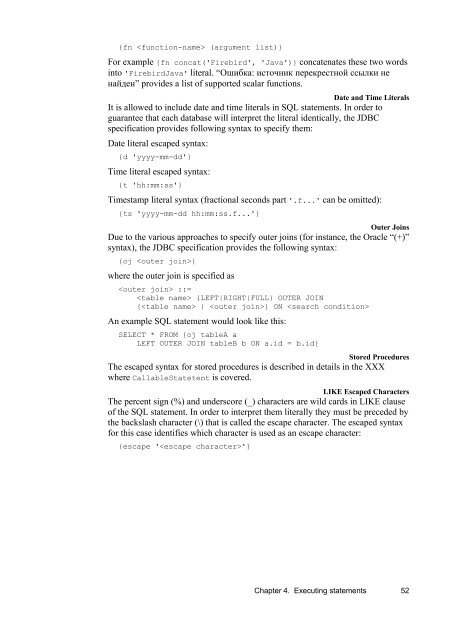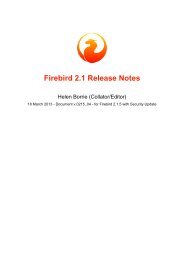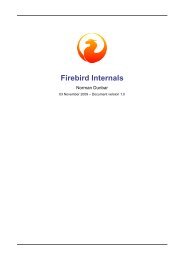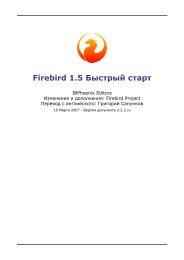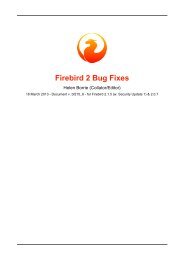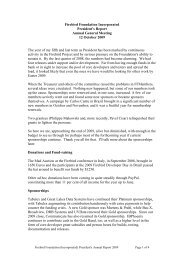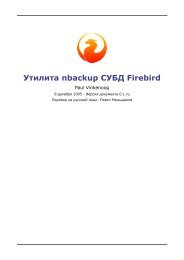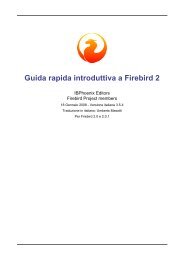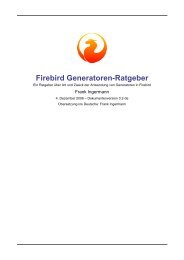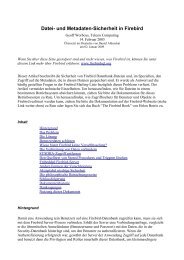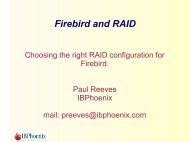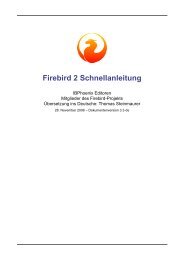Jaybird 2.1 JDBC driver Java Programmer's Manual - Firebird
Jaybird 2.1 JDBC driver Java Programmer's Manual - Firebird
Jaybird 2.1 JDBC driver Java Programmer's Manual - Firebird
You also want an ePaper? Increase the reach of your titles
YUMPU automatically turns print PDFs into web optimized ePapers that Google loves.
{fn (argument list)}<br />
For example {fn concat('<strong>Firebird</strong>', '<strong>Java</strong>')} concatenates these two words<br />
into '<strong>Firebird</strong><strong>Java</strong>' literal. “Ошибка: источник перекрестной ссылки не<br />
найден” provides a list of supported scalar functions.<br />
Date and Time Literals<br />
It is allowed to include date and time literals in SQL statements. In order to<br />
guarantee that each database will interpret the literal identically, the <strong>JDBC</strong><br />
specification provides following syntax to specify them:<br />
Date literal escaped syntax:<br />
{d 'yyyy-mm-dd'}<br />
Time literal escaped syntax:<br />
{t 'hh:mm:ss'}<br />
Timestamp literal syntax (fractional seconds part '.f...' can be omitted):<br />
{ts 'yyyy-mm-dd hh:mm:ss.f...'}<br />
Outer Joins<br />
Due to the various approaches to specify outer joins (for instance, the Oracle “(+)”<br />
syntax), the <strong>JDBC</strong> specification provides the following syntax:<br />
{oj }<br />
where the outer join is specified as<br />
::=<br />
{LEFT|RIGHT|FULL} OUTER JOIN<br />
{ | } ON <br />
An example SQL statement would look like this:<br />
SELECT * FROM {oj tableA a<br />
LEFT OUTER JOIN tableB b ON a.id = b.id}<br />
Stored Procedures<br />
The escaped syntax for stored procedures is described in details in the XXX<br />
where CallableStatetent is covered.<br />
LIKE Escaped Characters<br />
The percent sign (%) and underscore (_) characters are wild cards in LIKE clause<br />
of the SQL statement. In order to interpret them literally they must be preceded by<br />
the backslash character (\) that is called the escape character. The escaped syntax<br />
for this case identifies which character is used as an escape character:<br />
{escape ''}<br />
Chapter 4. Executing statements 52


